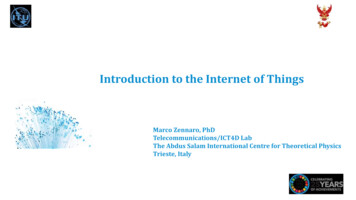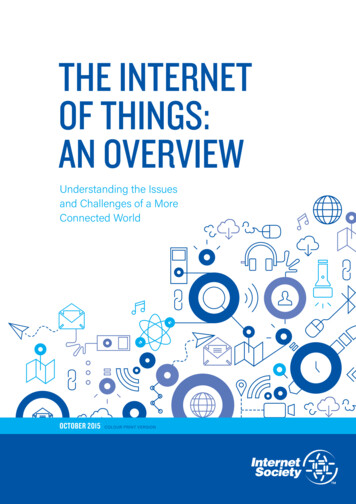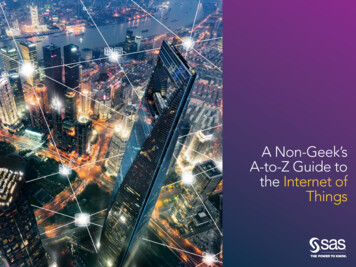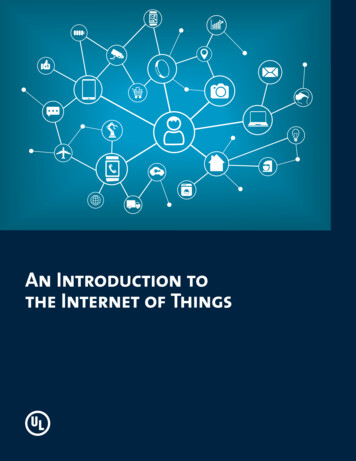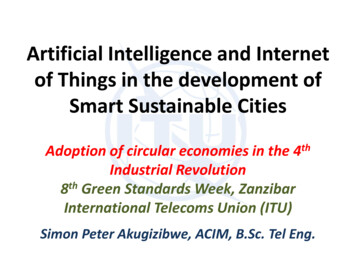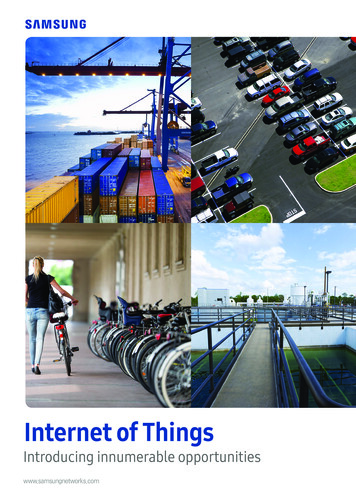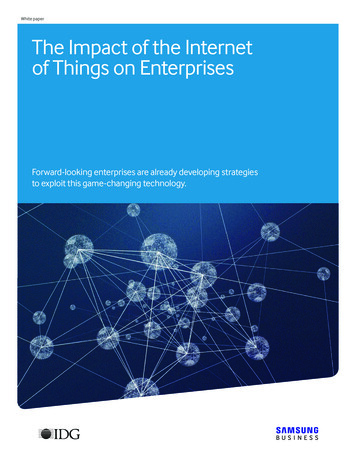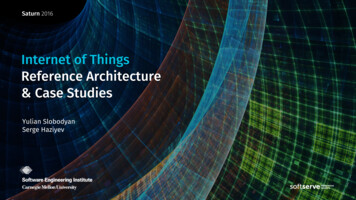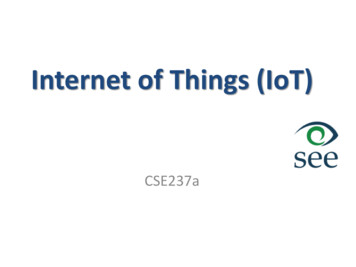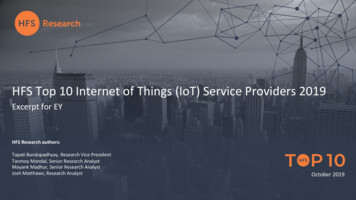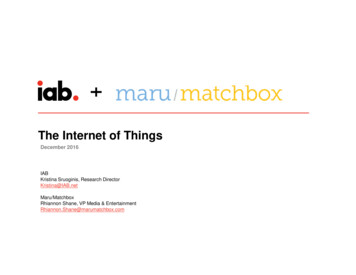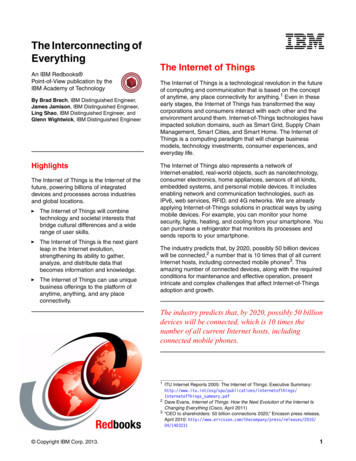
Transcription
The Interconnecting ofEverythingAn IBM Redbooks Point-of-View publication by theIBM Academy of TechnologyBy Brad Brech, IBM Distinguished Engineer,James Jamison, IBM Distinguished Engineer,Ling Shao, IBM Distinguished Engineer, andGlenn Wightwick, IBM Distinguished EngineerHighlightsThe Internet of Things is the Internet of thefuture, powering billions of integrateddevices and processes across industriesand global locations. The Internet of Things will combinetechnology and societal interests thatbridge cultural differences and a widerange of user skills. The Internet of Things is the next giantleap in the Internet evolution,strengthening its ability to gather,analyze, and distribute data thatbecomes information and knowledge. The Internet of Things can use uniquebusiness offerings to the platform ofanytime, anything, and any placeconnectivity.The Internet of ThingsThe Internet of Things is a technological revolution in the futureof computing and communication that is based on the conceptof anytime, any place connectivity for anything.1 Even in theseearly stages, the Internet of Things has transformed the waycorporations and consumers interact with each other and theenvironment around them. Internet-of-Things technologies haveimpacted solution domains, such as Smart Grid, Supply ChainManagement, Smart Cities, and Smart Home. The Internet ofThings is a computing paradigm that will change businessmodels, technology investments, consumer experiences, andeveryday life.The Internet of Things also represents a network ofInternet-enabled, real-world objects, such as nanotechnology,consumer electronics, home appliances, sensors of all kinds,embedded systems, and personal mobile devices. It includesenabling network and communication technologies, such asIPv6, web services, RFID, and 4G networks. We are alreadyapplying Internet-of-Things solutions in practical ways by usingmobile devices. For example, you can monitor your homesecurity, lights, heating, and cooling from your smartphone. Youcan purchase a refrigerator that monitors its processes andsends reports to your smartphone.The industry predicts that, by 2020, possibly 50 billion deviceswill be connected,2 a number that is 10 times that of all currentInternet hosts, including connected mobile phones3. Thisamazing number of connected devices, along with the requiredconditions for maintenance and effective operation, presentintricate and complex challenges that affect Internet-of-Thingsadoption and growth.The industry predicts that, by 2020, possibly 50 billiondevices will be connected, which is 10 times thenumber of all current Internet hosts, includingconnected mobile phones.123Redbooks Copyright IBM Corp. 2013.ITU Internet Reports 2005: The Internet of Things: Executive ternetofthings/InternetofThings summary.pdfDave Evans, Internet of Things: How the Next Evolution of the Internet IsChanging Everything (Cisco, April 2011)“CEO to shareholders: 50 billion connections 2020,” Ericsson press release,April 2010: 2010/04/14032311
Dimensions of the Internet ofThingsThe Internet of Things is based on three dimensions:components, building blocks, and system of systemsas shown in Figure 1. Components deliver foundationalcapabilities. Building blocks encompass producttechnologies that emerge from integrating new Internetof Things components and traditional technologycomponents. System of systems describes the uniqueways that building block can be combined, integrated,and deployed across industries.ComponentsDimensionsin a state ofthe art IoTBuildingblocksFor example, a car is a system that consists of multiplebuilding blocks and components. In city traffic, the carand driver interact with the city traffic systems tonavigate directions and traffic flow as a type of city-trafficsystem of systems. For an automobile manufacturer, thecontext switches to customer support systems. Theinformation that is gained on driving conditions, drivinghabits, security, and maintenance records is fed to themanufacturer’s customer support systems, forming acustomer-care system of systems. In both scenarios, theInternet-of-Things solution is the coordination andinteraction of many smaller systems, each with levels ofautonomy, dependence, and interaction.Other examples of system of systems include IBMSmarter Cities and Smart Grid, environment-based,ground transportation, aviation and aeronautics,security and surveillance. They also includepharmaceutical, medical and healthcare, retail, supplychain, processing and manufacturing, agriculture,grocery and food traceability, media and entertainment,and operational scenarios and business cases.System-of-SystemsBusiness challenges with theInternet of ThingsFigure 1 Dimensions of the Internet of ThingsComponents are specific to an application, meaningthat they are specific to the solution. For example, awater system uses meters, pressure and flow sensors,and value control components. Building blocks areitems that are common to many solutions but that arecritical to success. Examples include communications,security, analytic engines, remote compute nodes, andupdate engines.Building blocks are the backbone of many solutionsand include communications, security, analyticengines, remote compute nodes, and update engines.Other examples of building blocks include software,household appliances, mobile devices, security andprivacy technologies, and communication and networktechnologies. They also include consumer andbusiness electronics; land, air and water-basedvehicles; home automation technologies (includingmonitoring and metering); and Internet and networkprotocols (such as IPv6).Building blocks are used to create systems, which arethen combined to create a system of systems. Thedistinction in an Internet of Things world is defined bythe operational scenario that is being supported.2The Interconnecting of EverythingThe Internet of Things has arrived and will continue toevolve and affect corporate environments. Business andtechnology executives who are responsible for theseenvironments need to understand the challenges andapproaches to consider in an Internet-of-Things-centricecosystem. The primary focus must on criticaloperational considerations, such as scalability,availability, manageability, data management, security,and usability. These considerations are in the context ofa hybrid environment where many aspects of adeployment are not within the control of the corporation.ScalabilityAn Internet of Things environment contains twoscalability issues, each of which poses uniquechallenges for users and corporations. The firstscalability issue is based on the number of connecteddevices. The second issue is based on the volume ofgenerated data.Scalability issues for connected devices include thenumber of concurrent connections, or throughput, thata system can support and the quality of service (QoS)level that can be guaranteed. Here, Internet scalabilityis a critical factor. Currently, most Internet-connecteddevices use IPv4, which is based on a 32-bit
addressing scheme and is limited to 232(4,294,967,296) unique addresses. Considering thatInternet-of-Things forecasts describe a possible50 - 100 billion devices, optimum scalability wouldrequire migrating to IPv6, which implements a 128-bitaddressing scheme that can support up to 2128addresses (3.4 x 1038 devices). Several initiatives areunderway to influence the direction of IPV6 to enablethe Internet of Things. One such initiative is the IoT6project, which is focused on researching, designing,and developing a highly scalable IPv6-basedservice-oriented architecture.4Challenges for scalability that are based on datavolume highlight performance issues that areassociated with data collection, processing, storage,query, and display. Internet-of-Things systems need tohandle both device and data scalabilities.AvailabilityInternet-of-Things availability involves recoverabilityand reliability. End-to-end system availability mightrequire technical principles across components andbuilding blocks that are driven by specific industryuse-case needs.One architecture implication to availability is driven bythe increased demand around cloud computing andx-as-a-service, such as software as a service.Corporations must closely look at the implications tothe services and capabilities that are required of anInternet-of-Things environment. They might need tore-examine their cloud-based service-level agreements(SLAs) to determine whether they can obtain the levelof availability that is required.An innovative solution addresses fault avoidance, orfault intolerance, in ways that will facilitate a business tomeet customer expectations and enterprise needs, ifthe business has a hybrid environment of on-premiseand cloud solutions.ManageabilityCurrently, only IT-related systems, such as servers,computers, and storage devices, are managed under agovernance model. Although mobile devices, such asphones and tablets, are reasonably managed, mostother Internet-of-Things devices are not managedsystematically as part of a larger ecosystem. In theInternet of Things, most devices operate remotelywithout direct human interaction, which requiresmanagement of such devices in the same way, that is,remotely and without human intervention. Simplyapplying current network and systems managementtechniques and technologies is not sufficient. Newapproaches are needed to develop an Internet-of-Thingsarchitecture and to manage its lifecycle.Managing dataBig data and the Internet of Things are computingparadigms that, together, fundamentally change thenature of how we work, play, and interact with ourenvironment. Where big data is all about volume,velocity, verity, and veracity, the Internet of Things isabout using that data in meaningful ways to improveproductivity and quality of life.5For example, the Internet of Things can collecttemporospatial information, which is both temporal(time) and spatial (location) data. This information,when combined with analytic technology, provides newinsight into when, where, and how devices and humanscan or should interact. The key issue is howcorporations handle storing, managing, andmanipulating this data. Many corporations are alreadyusing such technologies as IBM SPSS , Tealeaf, andIBM Cognos to conduct complex analysis and gaininginsight into patterns, unusual events, and anomalies.The innovations come from using these technologies inan Internet-of-Things context to deliver new capabilitiesin support of key business processes such ase-commerce, supply chain, and customer experiencemanagement. However, to reach this level of capability,enhancements are needed in database, contentmanagement, and information technologies.SecurityTraditional lT security establishes secure boundariesand firewalls around internal IT systems. But with theInternet of Things, the concept of controlled access ischanging to one of controlled trust that offers thewidest range of possible solutions. Security challengesrequire Internet-of-Things implementations toeffectively deal with authorization, authentication,access control, privacy, and trust requirements withoutnegatively impacting usability.54IoT6 Project: http://www.iot6.euBig Data at the Speed of Business: What is big data:http://www.ibm.com/software/data/bigdata3
UsabilitySmart grid demand and responseUsability has a broad role in the solutions of the future.Traditionally, most IT solutions were task-based andallowed for task-based training. With Internet-of-Thingssolutions, this type of training can be complex andineffective, which requires devices to offer new andhigher usability levels that bridge cultural differencesand wide ranges of user knowledge and skills.Internet-of-Things systems can provide detailedvisibility of complex systems, which necessitate ausability design that allows ease-of-use and appealingaesthetics, multilingual support, and context help.In the energy, utility, and renewable energy industries,smart grid demand and response are critical elementsin managing the balance between demand andresponse, especially in the renewable energyresources industry. This balance remains a key factoras we continue to deploy distributed and renewableresources such as wind turbines and solar panels.From an Internet-of-Things perspective, the decisionsthat are made in these industries will directly impactother industries. For example, design choices inautomotive, consumer electronics, and homeappliances will factor in the ability to use and deployoptions that are provided by power companies.The Internet of Things uses innovation in manyfields, from wireless sensors tonanotechnology, making it a natural fit for theIBM Smarter Planet initiative.Cross-industry concepts forInternet of ThingsInternet-of-Things concepts affect almost all industriesand the solution capabilities that are provided, frombusiness smart grid demand and response, logistics tosmart home and services, as shown in Figure 2.Industry analysts predict that the Internet of Things willbe key in the areas of waste management, urbanplanning, sustainable urban environment, continuouscare, emergency response, intelligent shopping, smartproduct management, smart meters, home automationand smart events.Internet-of-Things-based demand and response systemscan integrate varied information sources, such as thepredicted output of distributed generators, the currentload of electrical grids, and the predicated usage ofelectrical vehicles and smart appliances. By usingreal-time and historical data, an Internet-of-Thingsdemand and response system can calculate and forecastthe balance point over a time range, automaticallysending control information to generators, electrical grids,and smart appliances, maintaining the desired balance.For example, a utility company can save a significantamount of money in new equipment while continuing tomaintain
the art IoT Components Building blocks System-of-Systems. 3 addressing scheme and is limited to 232 (4,294,967,296) unique addresses. Considering that Internet-of-Things forecasts describe a possible 50 - 100 billion devices, optimum scalability would require migrating to IPv6, which implements a 128-bit addressing scheme that can support up to 2128 addresses (3.4 x 1038 devices). Several .

